¿Estás listo para experimentar la emoción de surfear las olas? Como principiante, comenzar en el mundo del surf puede ser abrumador. ¡Pero no te preocupes! Con la orientación y los consejos adecuados, puedes progresar más rápido de lo que jamás creíste posible. Aquí tienes 31 consejos detallados de surf para principiantes diseñados para ayudarte a mejorar tus habilidades y disfrutar surfeando las olas de forma más eficaz.
1. Practica surf en un lugar apto para principiantes
Cada playa es única, con un ángulo de costa ligeramente diferente y formaciones de fondo oceánico variables. Los bancos de arena en las rompientes de playa cambian a diario; algunos lugares tienen olas con forma de tubo, mientras que otros están más protegidos. Si eres principiante, lo mejor es encontrar una playa con olas pequeñas pero potentes u olas que rompan más lejos y se adentren en forma de cal blanca. Busca playas con corrientes bajas, ya que te costará menos permanecer en el agua. Puedes encontrar esta información en aplicaciones y sitios web como Windy, Magic Seaweed o guías de surf locales. Estos son algunos de los consejos de surf que debes tener en cuenta.

Busque playas con olas suaves y onduladas que sean indulgentes para los principiantes. Estos lugares suelen estar poblados por otros surfistas principiantes, lo que los convierte en un entorno propicio y menos intimidante. Evite las áreas con olas potentes y poco profundas, ya que son más adecuadas para surfistas avanzados.
2. Utilice una tabla de surf grande
Entre los Consejos y trucos de surf para principiantes : un consejo clave es evitar apresurarse a usar tablas de surf más pequeñas. Si bien las tablas elegantes y profesionales son tentadoras, es fundamental que los principiantes se concentren en el desarrollo de habilidades con un equipo del tamaño adecuado antes de pasar a tablas más pequeñas.
Porque cuanto más grande y flotante sea tu tabla de surf, más olas cogerás. Y cuantas más olas cojas, más oportunidades tendrás de practicar y perfeccionar tu técnica, lo que te permitirá mejorar más rápido. Si utilizas una tabla demasiado pequeña, te resultará difícil. Coger olas , levantarse y practicar, lo que no deja margen para progresar. No cambies a una tabla más pequeña hasta que llegue el momento adecuado.
3. Consigue una tabla de techo blando
Como principiante en el surf, es importante priorizar la seguridad. Un consejo útil es utilizar una tabla con la parte superior blanda, ya que reduce en gran medida el riesgo de lesiones. Las tablas con la parte superior blanda están hechas con una cubierta de espuma, lo que las hace más tolerantes si chocas con la tabla durante una caída. También proporcionan una mejor estabilidad, lo que te facilita el equilibrio y el progreso en tu viaje de surf. ¡Recuerda considerar el uso de una tabla con la parte superior blanda para que tu experiencia de surf sea más segura y agradable!
4. Pase tiempo en tierra firme primero
Se recomienda encarecidamente practicar el pop-up en tierra antes de intentarlo en las olas. Puedes practicar en la playa o en cualquier otra superficie adecuada, como una colchoneta de yoga. Practicar el pop-up en tierra puede mejorar significativamente tu rendimiento en el surf. Se recomienda practicar incluso si ya has surfeado antes. Filmarte mientras practicas puede ayudarte a identificar áreas que necesitas mejorar.
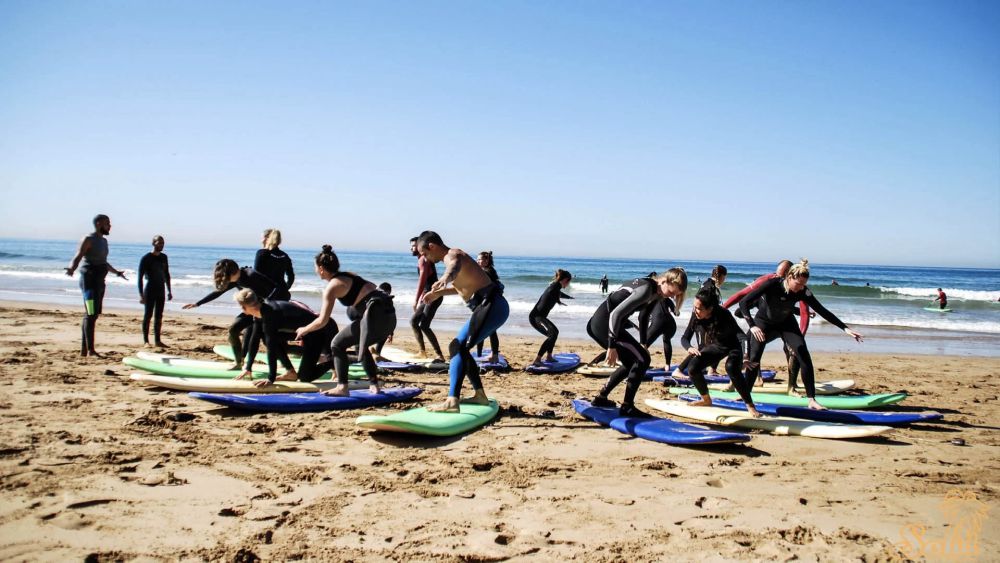
5. Controle su ritmo
El surf es una actividad físicamente exigente y es importante no precipitarse al entrar al agua. Empieza con algunos ejercicios de calentamiento suaves para preparar tu cuerpo para las exigencias físicas del surf. Las prisas pueden provocar fatiga y aumentar el riesgo de lesiones, así que tómate tu tiempo y acumula energía para disfrutar más de la sesión.
La maniobra de pop-up o despegue es una maniobra esencial Consejo de surf para principiantes : una técnica fundamental que no se limita a los principiantes. Incluso los surfistas profesionales perfeccionan continuamente esta habilidad para alcanzar la perfección. Esta maniobra es similar al saludo al sol del yoga, que practican tanto principiantes como expertos. El objetivo final es alcanzar un nivel de dominio en el que puedas ejecutar el movimiento sin esfuerzo, lo que te permitirá concentrarte por completo en surfear la ola con confianza.
6. Manténgase alejado de los surfistas experimentados
Respetar el espacio de los surfistas más experimentados en la formación es uno de los consejos para surfear . Evita interponerte en su camino o dejarte caer en sus olas. La etiqueta del surf dicta que el surfista más cercano a la ola que rompe tiene derecho de paso. Espera tu turno y garantiza la seguridad tanto de ti como de los demás en el agua.
7. Siéntese cómodamente en la tabla
Antes de empezar a coger olas, practica sentarte en tu tabla de surf en el agua. Encuentra una posición cómoda que te permita mantener el equilibrio sin volcarte. Esto te resultará útil cuando necesites descansar o esperar la ola adecuada.
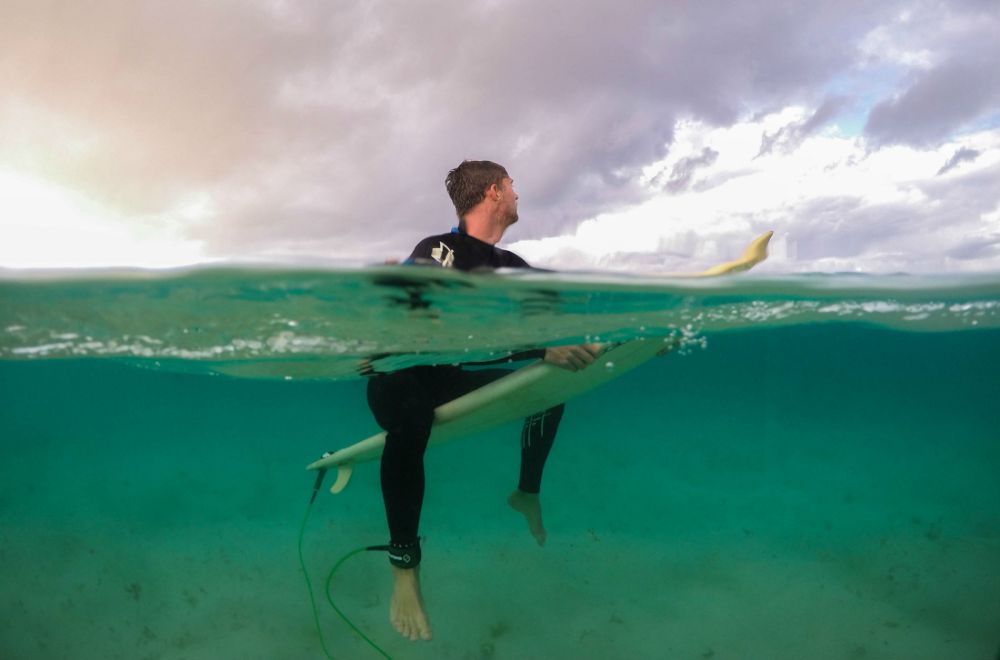
Además, para coger una ola, es importante sentarse en la tabla de forma que te permita reaccionar rápidamente cuando veas una ola adecuada. Una vez que encuentres el equilibrio, podrás practicar la transición de una posición sentada a una posición acostada y determinar qué lado es mejor para mirar hacia atrás y comprobar si se acerca una ola.
8. Remar con eficacia
Dominar la habilidad de surf remando es absolutamente esencial para cualquier surfista. Para atrapar más olas y ahorrar energía, practica encontrar un ritmo fuerte y mantenerlo mientras remas hacia la línea de salida. Con práctica constante, desarrollarás una remada potente y eficiente que te ayudará a surfear las olas con confianza y facilidad. ¡Así que no dudes en trabajar duro y esforzarte por alcanzar la excelencia en tu técnica de remada!
9. Acostúmbrate a borrar
Al caerse de la tabla, hay pasos adecuados Consejos de surf Para garantizar su seguridad. Puede parecer que la gente simplemente se da por vencida cuando se cae al agua, pero caerse correctamente puede ayudar a reducir el riesgo de sufrir lesiones al golpear el fondo del océano. Si practica regularmente la caída en aguas poco profundas, puede proteger su cabeza y su cuerpo.
El surf es para todos, así que no te preocupes por tomarte tu tiempo para aprender. Observar el agua es uno de los valiosos consejos para principiantes que te pueden ayudar a surfear de forma más inteligente y segura. ¡Solo disfruta!
10. Cuida el agua
Al principio, comprender los movimientos del océano mientras se practica surf puede resultar complicado. Pero cuanto más tiempo pases en el agua, más entenderás los patrones y ritmos de las olas. Esta comprensión te ayudará a predecir dónde romperán las olas. Puede que te lleve un tiempo, pero con la práctica mejorarás tu capacidad para interpretar el océano y posicionarte correctamente.
Por ejemplo, la luna influye en las mareas del océano, lo que provoca mareas altas y bajas. Estas mareas afectan el lugar donde las olas rompen en el fondo del océano. Durante la marea baja, las olas rompen más lejos de la orilla; durante la marea alta, rompen más cerca. Para mejorar tu experiencia de surf, debes averiguar el nivel óptimo de marea para el lugar de surf elegido, que son valiosos consejos para principiantes que pueden ayudarte a surfear de forma más inteligente y segura.
11. Practica el remo
Para coger olas mientras se practica surf, tener una buena técnica de remada no solo es importante, sino que es crucial. Trabajar regularmente en tus habilidades de remada te ayudará a descubrir el ritmo de remada más eficaz que te permita cubrir la mayor distancia con cada palada.
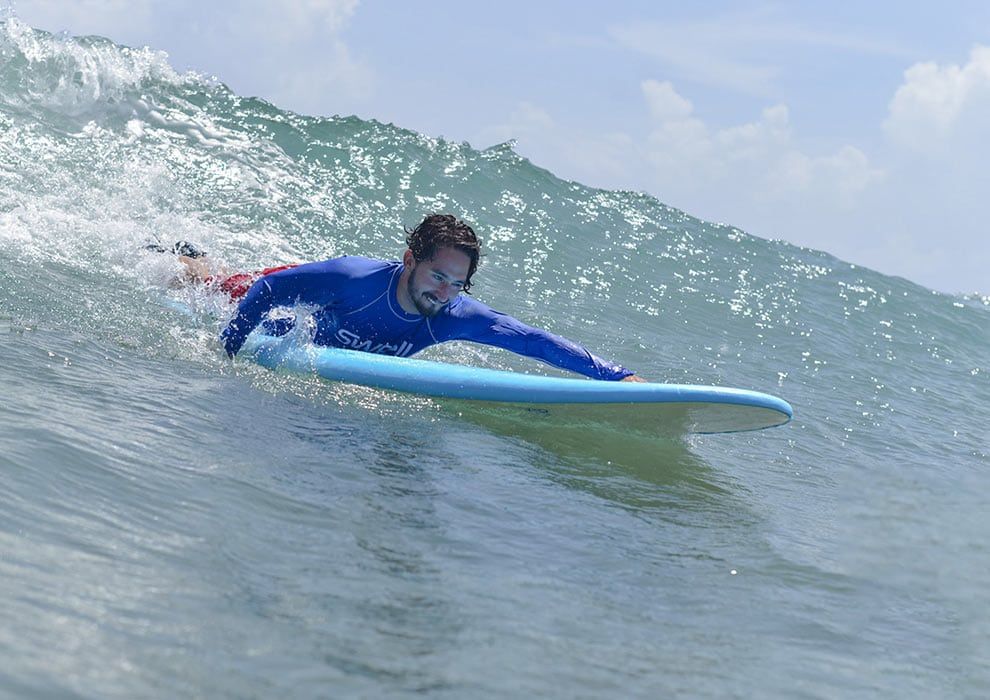
Incorporando especificidades ejercicios para hacer surf con remo Incorporar la tabla de surf a tu rutina puede mejorar significativamente este aspecto de tu práctica. Ejercicios como nadar largos para desarrollar resistencia, practicar saltos en tierra para mejorar la agilidad y usar una máquina de remo para fortalecer los músculos de la pala contribuyen a una técnica de remada más potente y eficiente.
Si remas de manera eficiente, cogerás más olas y conservarás energía para sesiones de surf más largas. Por lo tanto, encuentra el mejor ritmo de remada y practícalo con regularidad, junto con ejercicios específicos para remar en el surf, y seguramente mejorarás tus habilidades de surf rápidamente.
12. Encuentra el punto óptimo para remar
Al hacer surf, es importante experimentar con la posición en la tabla para encontrar el mejor lugar para remar. Remar demasiado hacia adelante o hacia atrás puede hacer que pierdas el equilibrio y te resulte más difícil atrapar olas. Tómate un tiempo para practicar y encontrar el "punto ideal" en el que tu tabla se deslice suavemente por el agua.
13. Domina la posición boca abajo
Cuando surfeas, la posición boca abajo se conoce como tumbarse sobre la tabla con el pecho hacia arriba, las manos apoyadas sobre la tabla, los codos metidos hacia adentro y los pies juntos. Para mantener el equilibrio en esta posición, debes encontrar el “punto ideal” en la tabla, que no está ni demasiado hacia adelante ni demasiado hacia atrás. Consejos para principiantes en el surf Esto evitará que la tabla se hunda o se desplome en el agua. También es importante mantener la cabeza erguida y mirar hacia adelante, no hacia abajo, a la tabla. Hacerlo te ayudará a detectar las olas y prepararte para la ola. La práctica regular en tierra firme y en el agua puede mejorar tu equilibrio, estabilidad y capacidad para atrapar olas.
14. Domina el popup
Una de las habilidades más importantes en el surf es el pop-up, que es la transición entre estar tumbado en la tabla y ponerse de pie para surfear la ola. Esto te permite coger más olas y surfearlas durante más tiempo.
Para levantarse sobre una tabla de surf, colóquese en posición vertical. Acuéstese sobre la tabla con los pies juntos y los dedos de los pies sobre la cola. El pecho hacia arriba, las manos planas, los codos hacia adentro y la mirada hacia adelante.
Cuando se acerca una ola, debes remar con fuerza para igualar su velocidad. A medida que la ola te eleva, debes impulsarte rápidamente con los brazos y colocar los pies debajo del cuerpo. La velocidad y el ritmo son clave; muévete rápidamente y atrapa la ola cuando comience a romper.
15. Empieza poco a poco
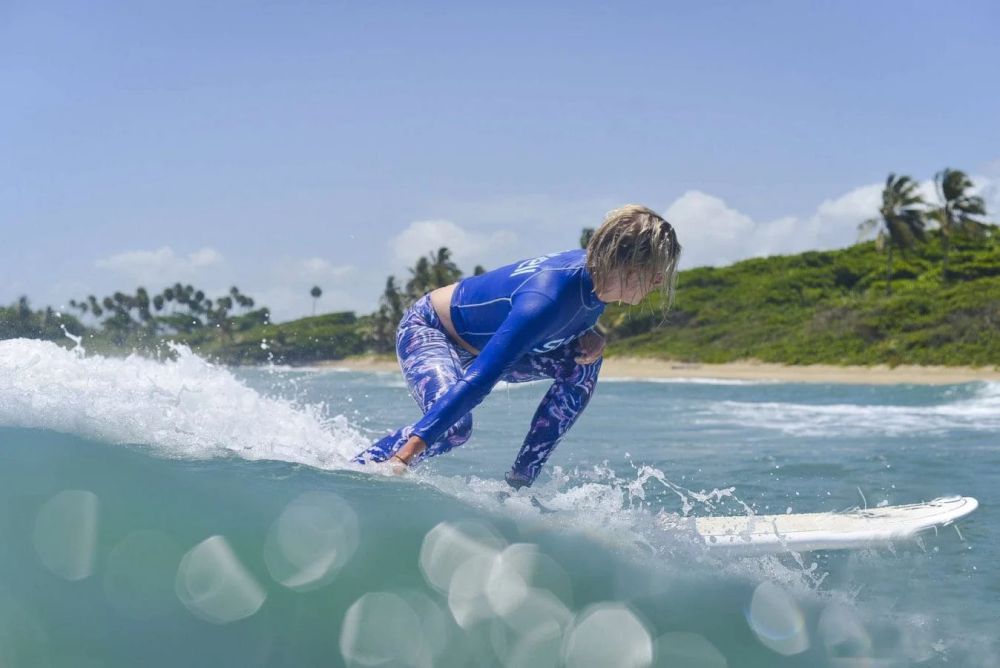
Mientras buscas Consejos de surf para principiantes : es recomendable empezar con olas más pequeñas antes de pasar a las más grandes. Este enfoque te ayudará a ganar confianza y mejorar tus habilidades gradualmente. Comenzar con olas más pequeñas es menos abrumador y más manejable, lo que te permite desarrollar tu confianza y tus habilidades gradualmente. Una vez que te sientas cómodo con olas más pequeñas, puedes progresar gradualmente a olas más grandes.
16. Evite caer en picado
Para evitar el desplome de nariz, un error muy común entre los principiantes, en el que la parte delantera de la tabla se hunde en el agua y haces una voltereta, debes encontrar el punto ideal en la tabla. Este punto suele implicar posicionarte en el medio de la tabla, donde tu peso se distribuye de manera uniforme. Mantener el peso centrado en la tabla te ayudará a mantener el equilibrio y evitar los desplomes de nariz.
17. Posicionamiento de los pies
Para valiosos Consejos de surf para principiantes Mantener el equilibrio y el control sobre la tabla es esencial. Una forma segura de lograrlo es mantener los pies cerca o sobre el encordador de la tabla. Esta posición proporciona una estabilidad y un control superiores, lo que te permite surfear las olas con facilidad y seguridad. Recuerda que el encordador es la línea central de la tabla, por lo que colocar los pies en esta zona es fundamental para mantener el equilibrio. Mantén los pies cerca del encordador en todo momento y, con la práctica, ¡te convertirás en un experto en surfear las olas como un profesional!
18. Postura correcta para surfear
Para lograr una postura adecuada para surfear, debes colocar el pie delantero en un ángulo de 45 grados, mientras que el pie trasero debe estar casi perpendicular a la cola de la tabla. Esta postura te dará estabilidad y control mientras surfeas. Mantén los brazos relajados durante toda la sesión de surf. Además, asegúrate de girar la rodilla trasera hacia adentro para tener un mejor equilibrio.
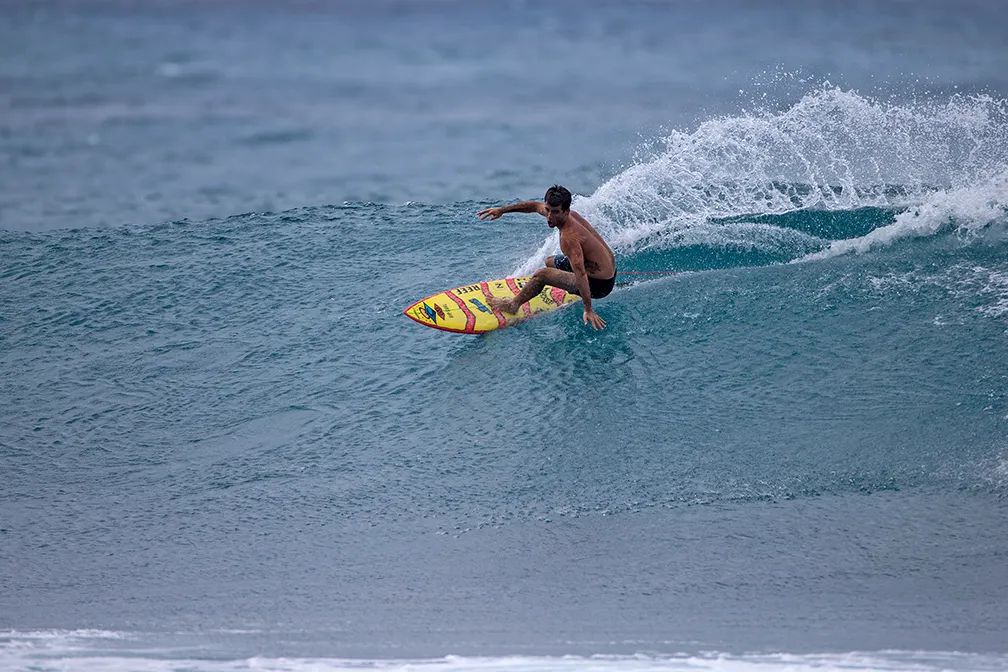
19. Dobla las rodillas
Mantener las rodillas dobladas mientras surfeas una ola es esencial para mejorar tu estabilidad. Esta técnica te dará más control y te ayudará a aprender giros y otras maniobras. Al bajar tu centro de gravedad, puedes absorber el movimiento de las olas y mantener el control, incluso en condiciones de mar picado.
20. Inclina tu despegue
Uno de los aspectos más importantes del surf es el despegue, que es el momento en el que te pones de pie sobre la tabla y empiezas a surfear la ola. Para dominar el despegue, debes inclinar ligeramente la tabla hacia la ola. Inclinar el despegue también te permite realizar giros y maniobras con mayor facilidad.
Para inclinar el despegue, debes mirar la ola y decidir en qué dirección ir. Luego, debes posicionar tu cuerpo y remar en consecuencia. A medida que la ola te eleva, debes levantarte rápidamente y girar la tabla con los pies y las caderas. Consejos para surfear Te ayudará a atrapar la ola más rápido, evitar caer en picada y surfear a lo largo de la cara de la ola.
21. Estírate antes y después
En muchos países europeos el aire es cálido y el agua fría, por lo que es importante preparar el cuerpo para el cambio. El surf requiere muchos movimientos repetitivos, como remar y levantarse, lo que puede provocar distensiones o lesiones si el cuerpo no está bien calentado.
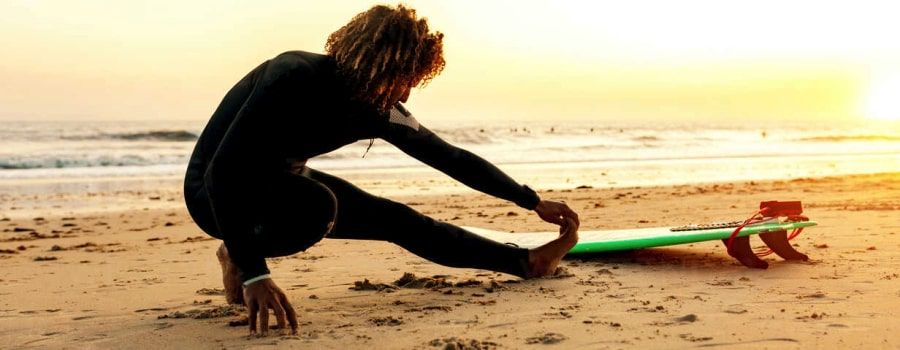
Puedes aumentar tu ritmo cardíaco con algunos ejercicios cardiovasculares, como 5 minutos de saltos de tijera y flexiones en la playa antes de remar, y no olvides estirar los brazos, la espalda, los hombros y las piernas.
No solo libera tu cuerpo para que se mueva de la forma que deseas en la ola, sino que también reduce drásticamente las posibilidades de sufrir lesiones. Desgarrarse un músculo el primer día de tus vacaciones de surf puede ser muy doloroso y arruinar tu viaje.
22. No pierdas de vista las olas entrantes
Para aquellos que buscan Consejos de surf para principiantes : es fundamental estar atento al agua. Puedes anticipar el tamaño, la forma y la dirección de las olas y elegir las mejores para atraparlas. También puedes evitar situaciones peligrosas como quedar atrapado dentro o chocar con otros surfistas.
También debes aprender a leer las olas y comprender sus patrones y comportamientos. Por ejemplo, debes saber cómo detectar el pico de la ola, que es el punto más alto donde comienza a romper. Es ahí donde debes posicionarte para atrapar la ola.
Puedes mejorar tu sincronización, posicionamiento y selección de olas si prestas atención a las olas que se aproximan. Esto te ayudará a atrapar más olas y a divertirte más en el agua.
23. Elige las ondas con cuidado
Seleccionar la ola adecuada para atrapar es una habilidad que se adquiere con la experiencia. Busque las olas que están justo detrás de usted, ya que son más fáciles de atrapar. Interpretar las olas y tomar decisiones estratégicas mejorará sus posibilidades de tener éxito en las olas.
24. Rema tres veces más
Un útil Consejo de surf para principiantes El objetivo es remar tres veces más después de coger una ola antes de ponerse de pie. Esto significa que cuando creas que has cogido una ola, debes remar tres veces más antes de intentar ponerte de pie. Este esfuerzo adicional garantiza que estés en la posición ideal para surfear la ola, lo que te ayudará a coger más olas y a mejorar tu ritmo. Este es uno de los consejos de surf más útiles para principiantes que puede marcar una gran diferencia en tu rendimiento.
25. Distribuye tu peso
¿Alguna vez has experimentado una parada repentina mientras surfeas una ola? Esto podría deberse a tu postura de surf y a la distribución del peso en la tabla. Si colocas demasiado peso en la parte trasera, la tabla puede disminuir la velocidad y detenerse. Para evitarlo, debes distribuir el peso de manera uniforme por toda la tabla. De esta manera, la tabla se deslizará sobre la superficie en lugar de hundirse.
Considere esta analogía: cuando está acostado sobre una tabla de surf y se desliza sobre una ola hacia la playa, puede tocar fácilmente la arena sin caerse. Esto se debe a que su peso se distribuye uniformemente sobre la tabla, lo que le da equilibrio y estabilidad. Aplique este mismo concepto cuando se ponga de pie sobre la tabla de surf. Puede mantener el equilibrio y evitar caerse distribuyendo su peso uniformemente.
26. Sea amable y considerado
El surf no se trata solo de montar olas, sino también de compartir el océano con otros surfistas. Sé amable, cortés y considerado con los demás surfistas en la alineación. Respeta su espacio y sigue siempre las reglas no escritas de la tabla. Etiqueta del surf .
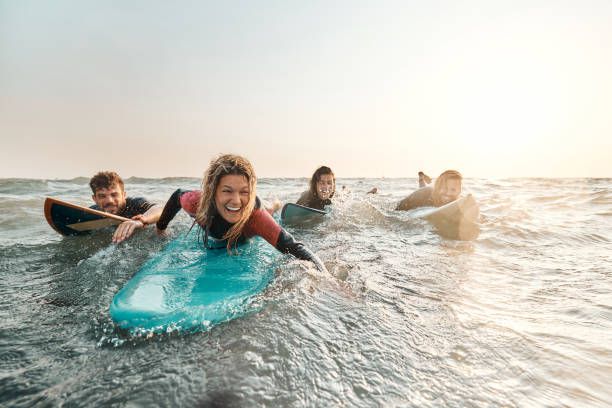
27. Disculpas por los errores
Los errores ocurren, especialmente cuando estás aprendiendo a surfear. No dudes en disculparte si chocas sin querer con alguien o cometes un error en el agua. Reconocer tus errores y mostrar humildad es de gran ayuda para mantener un ambiente positivo en la formación. Pedir disculpas por los errores es un consejo de surf simple pero efectivo para principiantes que puede ayudarte a evitar conflictos y ganarte el respeto de otros surfistas.
28. Sé indulgente
Así como debes perdonar tus propios errores, sé paciente y tolerante con los demás surfistas. Todos hemos sido principiantes en algún momento y aprender a surfear puede ser un desafío. Evita enojarte o confrontarte con los demás por pequeños errores.
29. Respeta a los surfistas locales
Al practicar surf en un lugar nuevo, es importante reconocer y mostrar respeto a los surfistas locales que están familiarizados con el lugar. Suelen tener prioridad en la alineación y pueden brindar información valiosa sobre las condiciones y la etiqueta locales. Respetar a los surfistas locales es un consejo crucial para principiantes que puede ayudarlo a evitar problemas y aprender de los expertos.
30. Evite pararse sobre las rodillas
Los surfistas principiantes a menudo se ponen de pie sobre sus rodillas en lugar de ponerse de pie, lo que es un mal hábito que puede obstaculizar su progreso y limitar su equilibrio y control sobre la tabla.
En lugar de eso, pasa directamente de estar acostado sobre la tabla a estar de pie con un movimiento suave y sin tocar la tabla con las rodillas. Esto hará que tu salto sea más rápido y suave. También tendrás más control y estabilidad sobre la tabla.
Usa una tabla de surf de lona o una tabla larga para mejorar tus habilidades de surf y practica en arena o en aguas tranquilas. Fortalece el torso y la parte superior del cuerpo con flexiones, planchas y burpees.
31. Consejos de seguridad
Priorizar siempre Seguridad en el surf . Usa una correa para evitar que la tabla se te escape en el agua. Además, evita lanzarte de cabeza en aguas poco profundas para evitar lesiones graves. Sé consciente de tu entorno y de los posibles peligros en el océano.
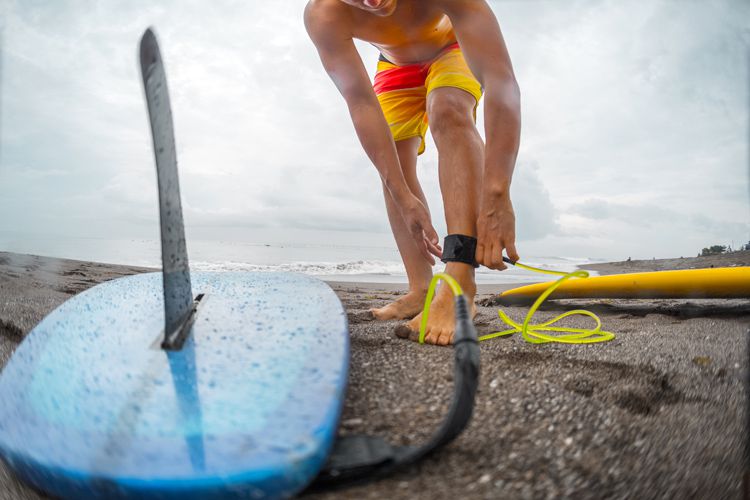
Reflexiones finales sobre consejos de surf para principiantes
El surf es un deporte desafiante pero gratificante. Con estos Consejos de surf para principiantes : estarás en el camino correcto para convertirte en un surfista seguro y hábil.
Para mejorar aún más tu experiencia de surf, especialmente como principiante, considera la innovadora aleta Boost. Esta herramienta está diseñada para darle a tu surf una ventaja significativa. La aleta Boost es un accesorio único que se fija a tu tabla de surf, ofreciendo propulsión adicional en el agua. Este impulso adicional puede ser increíblemente beneficioso para los principiantes que aún están dominando las técnicas de remada y captura de olas.
Con Boost Fin, puedes:
- Mejora la eficiencia al remar: ayuda a conservar energía mientras remas hacia las olas, lo que garantiza que tengas más resistencia para tu sesión de surf.
- Mejora la captura de olas: la propulsión adicional facilita la captura de olas, un desafío común para los principiantes. Esto significa más surf y menos esfuerzo.
- Desarrolla la confianza: al hacer que remar y atrapar olas sea más fácil, Boost Fin permite a los principiantes concentrarse en otras habilidades esenciales como el equilibrio y la maniobrabilidad.
- Disfrute de sesiones más largas: la reducción de la fatiga al remar significa que puede disfrutar de sesiones más largas en el agua, lo cual es crucial para la práctica y la mejora.
- Seguro y fácil de usar: diseñado teniendo en cuenta la seguridad, Boost Fin es un complemento fácil de usar para su tabla de surf, fácil de instalar y operar.
Recuerda que, como en cualquier deporte, la clave del éxito en el surf es la práctica y la paciencia. Así que, ¡sal, diviértete y surfea esas olas! Aleta de refuerzo en Boost Surfing y descubre cómo puede transformar tu experiencia de navegación.


Compartir:
Los 13 mejores lugares para surfear en marzo
¿Cuánto tiempo se tarda en aprender a surfear?